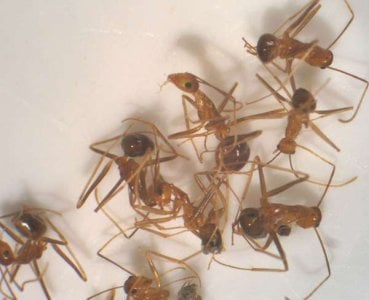Protect your homes from this invasive pest wreaking havoc during spring!
By
Danielle F.
- Replies 11
As the winter season comes to an end, the Australian spring season starts to warm up our homes.
As the cosy season approaches, a tiny yet formidable adversary is threatening to unleash an ecological and economic disaster upon communities.
The yellow crazy ant (YCA), an invasive pest with a notorious reputation, is becoming increasingly active and has caught the attention of experts.
Invasive Species Council's Advocacy Manager Reece Pianta highlighted the urgency of the situation.
Mr Pianta explained that the YCAs thrive in warmer weather.
'This period is extended with the warm late weather, which generally means there are more food sources to forage so ants become more active,' he stated.
First detected on Australian shores in 1934, the YCAs have been prevalent in Queensland, the Northern Territory, and New South Wales.
Their proliferation could be a significant threat to Queensland's Wet Tropics World Heritage Area—one of the oldest surviving tropical rainforests.
Local authorities in Cairns, Townsville, the Whitsundays, and Brisbane City have been managing YCA infestations.
Yellow crazy ants are known for frenzied activities when disturbed—which also explains how it earned its name.
These ants are highly aggressive compared to other insects and could decimate food resources fast.
These ants are particularly attracted to sugar cane—a crop vital to Australia's economy.
With around 95 per cent of the nation's sugar produced in Queensland and five per cent in northern NSW, the potential damage to this industry is alarming.
The threat of YCA extends beyond crops.
While they do not bite, they use formic acid to blind and kill prey.
Despite their small size, they could form super colonies and overpower larger animals like lizards, frogs, small mammals, turtle hatchlings, and bird chicks.
Yellow crazy ants also pose health and safety risks for outdoor and agricultural workers in tropical environments.
The YCAs could also infest homes.
Several reports stated large infestations in roofs and electrical fittings and could even attack residents.
Mr Pianta warned that the ants' ideal habitats include tourist destinations, which could deter visitors and impact the tourism sector.
He also called for additional funding and systematic eradication efforts to prevent YCA swarming.
As of writing, responses against the YCAs are left to local authorities, who often struggle with reliable funding and pest control.
More support for local councils and environmental groups is crucial.
As we enjoy the beauty of spring, it's essential to remain vigilant and support efforts to control this invasive pest.

Have you encountered yellow crazy ants in your area? Share your experiences and tips for dealing with this pest in the comments section below.
As the cosy season approaches, a tiny yet formidable adversary is threatening to unleash an ecological and economic disaster upon communities.
The yellow crazy ant (YCA), an invasive pest with a notorious reputation, is becoming increasingly active and has caught the attention of experts.
Invasive Species Council's Advocacy Manager Reece Pianta highlighted the urgency of the situation.
Mr Pianta explained that the YCAs thrive in warmer weather.
'This period is extended with the warm late weather, which generally means there are more food sources to forage so ants become more active,' he stated.
First detected on Australian shores in 1934, the YCAs have been prevalent in Queensland, the Northern Territory, and New South Wales.
Their proliferation could be a significant threat to Queensland's Wet Tropics World Heritage Area—one of the oldest surviving tropical rainforests.
Local authorities in Cairns, Townsville, the Whitsundays, and Brisbane City have been managing YCA infestations.
Yellow crazy ants are known for frenzied activities when disturbed—which also explains how it earned its name.
These ants are highly aggressive compared to other insects and could decimate food resources fast.
These ants are particularly attracted to sugar cane—a crop vital to Australia's economy.
With around 95 per cent of the nation's sugar produced in Queensland and five per cent in northern NSW, the potential damage to this industry is alarming.
The threat of YCA extends beyond crops.
While they do not bite, they use formic acid to blind and kill prey.
Despite their small size, they could form super colonies and overpower larger animals like lizards, frogs, small mammals, turtle hatchlings, and bird chicks.
Yellow crazy ants also pose health and safety risks for outdoor and agricultural workers in tropical environments.
The YCAs could also infest homes.
Several reports stated large infestations in roofs and electrical fittings and could even attack residents.
Mr Pianta warned that the ants' ideal habitats include tourist destinations, which could deter visitors and impact the tourism sector.
He also called for additional funding and systematic eradication efforts to prevent YCA swarming.
As of writing, responses against the YCAs are left to local authorities, who often struggle with reliable funding and pest control.
More support for local councils and environmental groups is crucial.
As we enjoy the beauty of spring, it's essential to remain vigilant and support efforts to control this invasive pest.
Key Takeaways
- Pest control authorities warned that yellow crazy ants (YCA) are becoming more active and could be a threat to Australian agriculture and tourism.
- Yellow crazy ants have been classified as one of the most damaging invasive species globally, with established populations in Queensland, the Northern Territory, and NSW.
- These ants do not bite but could spray formic acid to kill prey and could form super colonies.
- Experts called for more systematic eradication efforts and reliable funding to combat YCA infestations to prevent potential economic and ecological disasters.








